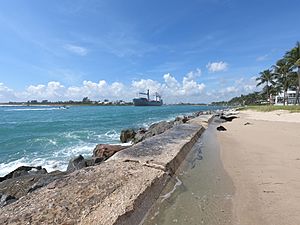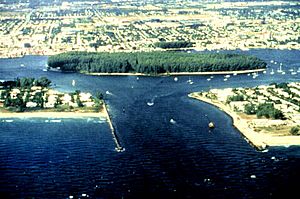Lake Worth Inlet facts for kids
The Palm Beach Inlet, also known as the Lake Worth Inlet, is a man-made channel. It cuts through a narrow strip of land called a barrier island. This channel connects the northern part of the Lake Worth Lagoon in Palm Beach County, Florida to the Atlantic Ocean.
The town of Palm Beach is on the south side of the inlet. To the north is the town of Palm Beach Shores. This inlet is also the main entrance for ships going to the Port of Palm Beach. You can find it at these coordinates: 26°46′20″N 80°02′14″W / 26.77222°N 80.03722°W.
Contents
The Story of Palm Beach Inlet
How Lake Worth Became an Inlet
In the mid-1800s, the body of water we now call the Lake Worth Lagoon was a freshwater lake. It was named Lake Worth to honor William J. Worth. He was a commander in the Second Seminole War.
No rivers flowed into this lake. All its water came from the Everglades to the west, seeping through the ground. The only way water left the lake was through a swamp. This swamp later became the Lake Worth Creek, leading to the Loxahatchee River and Jupiter Inlet.
The First Dig: Lang's Inlet
In 1866, people traveling in the area noticed something new. Fresh water was pouring from the lake into the ocean. This was happening about ten miles south of the Jupiter Inlet. Some reports say a settler named Lang dug this channel. For a while, it was even called Lang's Inlet.
This new cut drained the lake down to sea level. Some ocean water came in through the inlet. But fresh water kept seeping from the Everglades. This meant the lake stayed only a little bit salty, or brackish.
Challenges and New Attempts
The first inlet often filled up with sand. People had to dig it out again every few months. In 1877, settlers around the lake decided to try something new. They wanted to dig an inlet about a mile north of Lang's Inlet. This spot had a rock formation called the Black Rocks. They hoped these rocks would help protect the new inlet.
The barrier island at this chosen spot was only about 300 feet wide. But the sand dune ridge was 20 feet high! It was also covered in thick plants. All the work was done by hand. Twenty men used axes, shovels, hoes, and wheelbarrows. It took them several weeks to dig this new inlet.
This new inlet worked well for a time. However, it slowly moved south. The current wore away the southern bank. It also dropped sand on the northern bank. By 1886, the inlet had moved about a mile south of the Black Rocks. A storm then closed it completely. So, another inlet was dug again, just south of the Black Rocks.

Modernizing the Inlet
In 1893, Henry Flagler helped make the inlet bigger. Flagler was building his Florida East Coast Railway to West Palm Beach. His railway reached West Palm Beach in 1894.
The United States government said no to improving the inlet in 1912. But in 1915, the Florida Legislature created the Lake Worth Inlet District. This group later became the Port of Palm Beach District. They chose the spot of the original Lang's Inlet for a new, improved channel. This new inlet was finished in 1917.
The old inlet at the Black Rocks was still open. A group of fishermen from The Bahamas had settled on the barrier island near the Black Rocks. They would clear the channel when it filled with sand. A storm closed this old inlet in 1919. The fishermen, who were living on the island without permission, had to leave. They moved to Riviera, which is now Riviera Beach.
The new Lake Worth Inlet was made better many times over the next ten years. In 1935, the federal government took over responsibility for the inlet. They kept making it wider and deeper. They also built up the jetties, which are structures that protect the channel.
In 1967, the inlet was dug to a depth of 35 feet. It has stayed that deep ever since. There's also a special plant that pumps sand. It moves sand from the north side of the inlet to the south side. This helps keep the natural flow of sand moving south along the coast.


